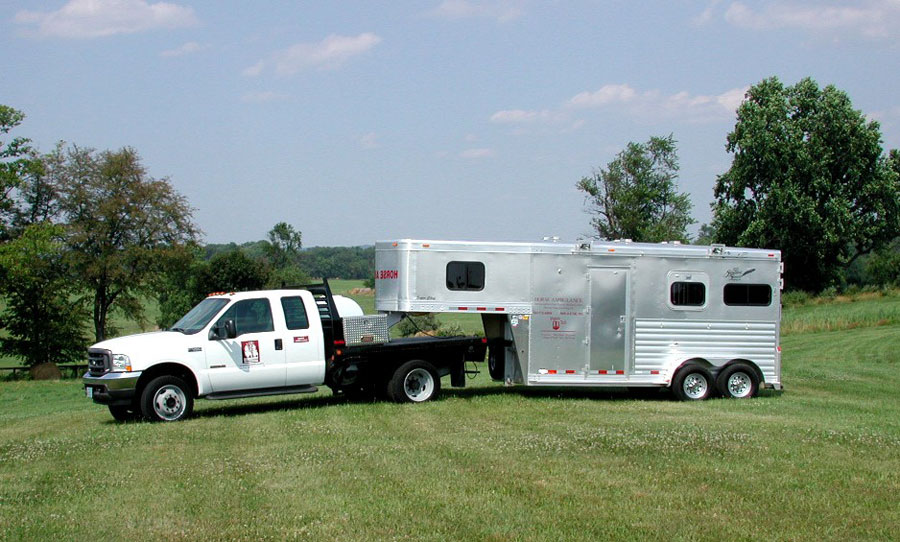Equine medical center's horse ambulance provides important services at Virginia equine events

They travel up to five hours one way to staff an event — and during the whole trip, they hope their services won't be needed when they get there.
The five-member ambulance crew from Virginia Tech’s Marion duPont Scott Equine Medical Center and their well-equipped rig provide emergency care and transport services to horses that incur injuries in steeplechase and point-to-point events which take place throughout the Mid-Atlantic region.
The ambulance — the only vehicle of its kind in Virginia — is on hand during numerous equine events during the spring and fall seasons. “If a horse is injured during an event, we have the ability to triage and transport him, under the guidance of a veterinarian, to a nearby site where the veterinarian can examine him further,” said John Dashiell, who oversees the equine medical center’s ambulance service.
Like any ambulance, this rig is designed and equipped to be of enormous use in an emergency situation. “In configuring and stocking the ambulance, we went about things very methodically,” Dashiell explained.
“The trailer, for instance, started off as standard issue equipment,” Dashiell noted, “but even before we obtained it, we had plans for adding structural reinforcement and adjustable breast bars, electrical outlets, a winch capable of pulling up to 8,000 pounds, and work-area lighting,” he said. “We customized it so it better serves veterinarians’ and injured horses’ needs.”
As an example, the adjustable breast bar allows for a variety of configurations. The center partition and bars can be moved to separate two adult horses or allow a mare and her foal to stay together. Or, the bars can be shifted to one side so an injured horse has additional support. The bars can also be removed to accommodate a recumbent horse.
“In stocking the ambulance, we did our research,” Dashiell said. “We asked veterinarians what they needed most, and put those items on board. One of the most important items we carry is water — and lots of it. Every time we go out,” he noted, “we have 170 gallons of water, which we primarily use to cool horses down if they’ve become overheated.”
Other supplies include various sizes and types of splints, bandage materials, high-volume fans, and a misting unit. “We also carry a strong, lightweight skid that we can use to move or transport a horse even if he’s unable to walk on his own,” Dashiell said.
The need for the ambulance service increases every year, and Dashiell, who has received formal instruction in search and recovery as well as emergency responder training, would like to see it at even more events, carrying additional equipment and supplies, and crewed by a staff that has undergone more formal training. But he says he knows that time and funding are limited.
“The thing is, we wouldn’t be able to do this at all if it weren’t for private donations made by a generous clientele and members of the equine community; they’re the ones who provided the funds to purchase this equipment,” he explained. “And, bear in mind, this is not a profit center; the charges for our services only cover our costs to maintain and operate the ambulance.”
When the ambulance is put to use, the crew says they find that horse owners are very appreciative. “The feedback we get is extremely positive,” said Dr. Nathaniel White, equine medical center director. “John takes a great deal of pride in the ambulance service, and because of this dedication, the race committees and veterinarians now depend on having a dedicated team to help injured horses. Our goal is to make sure we provide optimal care for the horses.”
“The accolades are great, but all credit for the program should really go to everyone who is involved with it — from the ambulance crew to the donors who helped purchase the equipment, to horse owners, to veterinarians who provide their services at equine events, to riders and trainers, and to event officials. All successes hinge entirely on the combined effort of everyone involved,” Dashiell said. “It’s truly a team effort.”
Though Dashiell stresses the teamwork that goes into operating the ambulance service, in 2006 he was singled out for a prestigious award for his outstanding contributions as a volunteer on behalf of the Virginia Point-to-Point. He was presented with the Virginia Huntsman Award, “which was just a tremendous honor,” Dashiell said.
Speaking with Dashiell, the passion and enthusiasm he has for the equine medical center ambulance service is evident. “We’re the only ones within hundreds of miles who can provide this type of service,” he noted. “When we support an event, it’s very likely that at least one of our donors will be attending. On that day, when they see us there, I hope they are as proud of this team and this service as they were on day one.”




.jpg.transform/m-medium/image.jpg)